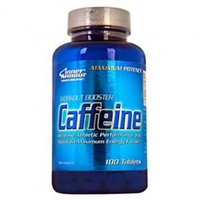-
Home
-
Contributors
-
International
-
Account
-
Information
More From Contributor

Inner Armour Caffeine 100 Capsules
of cAMP (cyclic AMP) and in the process amplifying the effects of the body’s natural lipolytic hormones epinephrine and norepinephrine.During the lipolytic (fat mobilizing) signaling cascade, natural hormones like norepinephrine and epinephrine (or synthetic analogs like ephedrine or clenbuterol) bind to so-called alpha-1 and beta-1 and beta-2 adrenergic receptors on the surface of fat cells, activating cyclic Adenosine Monophosphate, or cAMP. cAMP ultimately acts to turn on the enzyme Hormone Sensitive Lipase (HSL). HSL breaks up stored fat so that it can be used for fuel.In addition, cAMP is deactivated by an enzyme called phosphodiesterase. Caffeine inhibits the action of phospodiesterase thereby prolonging lipolysis. Besides acting as a cutting agent, caffeine possesses
ergogenic (sports performance enhancing) properties. The fat burning/glycogen sparing effect above may contribute to this.For adults of 18 years of age and over: 100-200mg not more than every 3 to 4 hours. Recommended daily dose: Take one tablet or as desired.
This page now acts as a permanent archive for this product. Add more information using the comments box below to ensure it can still be found by future generations.
Use our search facility to see if it is available from an alternative contributor.
- Availability: Out Of Stock
- Supplier: The Health Bay
- SKU: IA-CAFF
Product Description
Inner Armour Caffeine is perhaps the most widely used agent to mobilize fat for use as fuel, & one that actually helps burn that fat by elevating energy expenditure (basal metabolic rate). Several studies have shown that caffeine promotes lipolysis, the breakdown of stored fats into fatty acids which can be used by working muscle & other tissues for fuel while sparing glycogen in the process. Benefits:• Promotes lipolysis (the breakdown of stored fats) so they can be burned for energy• Promotes increased exercise performance & endurance• Spares glycogen (the muscle’s sugar energy stores) The traditional theory on how caffeine promotes lipolysis rests on the fact that at relatively high concentrations caffeine acts as a phophodiesterase inhibitor, maintaining elevated levels of c AMP (cyclic AMP) & in the process amplifying the effects of the body’s natural lipolytic hormones epinephrine & norepinephrine. During the lipolytic (fat mobilizing) signaling cascade, natural hormones like norepinephrine & epinephrine (or synthetic analogs like ephedrine or clenbuterol) bind to so-called alpha-1 & beta-1 & beta-2 adrenergic receptors on the surface of fat cells, activating cyclic Adenosine Monophosphate, or c AMP. c AMP ultimately acts to turn on the enzyme Hormone Sensitive Lipase (HSL). HSL breaks up stored fat so that it can be used for fuel. In addition, c AMP is deactivated by an enzyme called phosphodiesterase. Caffeine inhibits the action of phospodiesterase thereby prolonging lipolysis. Besides acting as a cutting agent, caffeine possesses ergogenic (sports performance enhancing) properties. The fat burning/glycogen sparing effect above may contribute to this. For adults of 18 years of age & over: 100-200mg not more than every 3 to 4 hours. Recommended daily dose: Take one tablet or as desired.
Reviews/Comments
Add New
Intelligent Comparison
We couldn't find anything!
Perhaps this product's unique.... Or perhaps we are still looking for comparisons!
Click to bump this page and we'll hurry up.
Price History
We couldn't find any historical pricing!
Vouchers
Do you know a voucher code for this product or supplier? Add it to Insights for others to use.
Jargon Buster
Supplier Information
Free delivery for orders of £40 or more.


 United Kingdom
United Kingdom
 France
France
 Germany
Germany
 Netherlands
Netherlands
 Sweden
Sweden
 USA
USA
 Italy
Italy
 Spain
Spain





 Denmark
Denmark